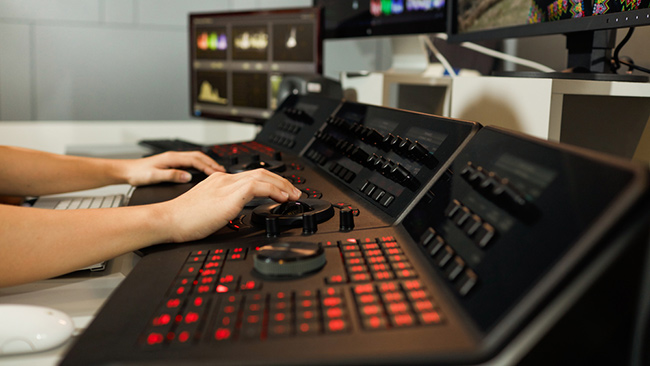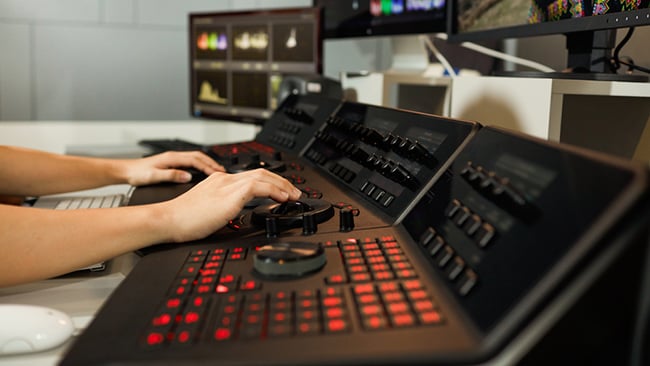

Anyone who has spent time in the editing room can quickly identify the hallmarks of the stereotypical post-production environment: a small, dark, windowless room in which the air conditioning is usually turned up to eleven. Being in post also means spending long hours sitting in front of a computer, gripping mice, and clicking away at keyboards, all of which can be both physically and physiologically daunting. How can we make this task a much more pleasant one?
This isn’t always the case in Post, but it’s a reality that many editors face for extended periods of time. I've decided to investigate what could be done to improve the atmosphere and make those 10+ hour days sitting around the NLE a little more comfortable.
Chair Options
In Post, we spend an uncanny number of hours with our rear-ends in a chair, so it’s important that we combat the acceptance of whatever chair has been haphazardly tossed into the room. Occasionally this means you might have to bring your own chair. I’ve found three decent replacements for the average office chair:
‘Yoga Ball’ sitting chairs – Basically a large inflated athletic ball with a backrest. These sorts of chair essentially force you to use your body as additional support thus encouraging good posture. This is also the major downside to these sorts of chairs: you basically need to be ‘on’ while sitting in them, which can be distracting while attempting to focus.
Kneeling Chairs — Yes, they look a little funny, but they require less constant focus than the Yoga Ball chairs. While they do encourage good posture, you still have a little leeway for slumping now and then.
Drafting Chair — I am a huge fan. They are adjustable to a variety of desk heights (including standing desks!), offer reasonable back support, a footrest, and typically don't have arms, which I feel get in the way while I work.
The Standing Desk
The standing has become very popular in the editing room, and they’re certainly something worth investigating. Standing at a desk is a straightforward way to avoid the “chair fatigue” scenario, but hours of continuous standing can equally put stress on your body.
If you’re going to go the standing desk route, investing in an anti-fatigue mat is a good idea. Combine this with a drafting chair to mix up the sitting and the standing, and a comfortable pair of shoes and you have yourself a winning situation.
Mice & Keyboards
After a few weeks in edit, I typically start developing a serious pain in my hand from scrubbing around footage and generally being hunched over one input device or another.
To combat this I've been shifting away from using standard mice and track pads as my primary pointing device. Right now that means using a tablet, which I love for most purposes. Some software just doesn't jive well with using a tablet, for which there are a few other options to explore.
The most peculiar of which is the "handshake" mouse, so named for its vertical design in which your hand sits upright while you use it. The concept behind this is that you're not twisting your wrists while you use the mouse, thus reducing strain.
The trackball mouse is a stationary mouse with a trackball that one rolls with their fingers. In addition to the benefits of reduced wrist strain, these mice often have a number of customisable buttons that you can program NLE shortcuts to.
Using a separate interface controller can also cut down on mouse / keyboard related stress. These devices are typically designed with editors in mind (think the Contour Control Shuttle and LightWorks Console), thus putting all the tools you'll need in a layout that tends to be easier on the hands. Additionally, you might want to look at USB foot pedals. Typically used for transcription software, the pedals can be assigned different keyboard shortcuts and are great for the typical J-K-L or space-bar shuttle commands.
When it comes to keyboards, I recommend avoiding any sort of fancy ‘ergonomic’ style layouts. The way these keyboards are broken up may be great for touch typists, but they just seem to get in the way of using keyboard commands in an NLE. However, investing in some kind of wrist guard to keep in front of a normal keyboard to prevent slumped wrists is well worth it.
Atmosphere and Décor
A number of editors I know (of all ages) enjoy littering the room with toys and other tidbits to bring a more homely flair to an otherwise sterile environment. Some other things to consider:
The Common Sweat-shirt — Quite possibly the most important part of any post-survival kit. It’s 95° degrees outside, yet for some reason, the editing room holds steady at a crisp 55°F. This is where the comfort of the common sweat-shirt or light sweater comes into play.
Coffee Mug — For holding coffee, tea, and/or whiskey.
Small Lamp — To brighten up an otherwise dark space. I go for ones with a tungsten-like glow.
The Most Important Advice
Frankly, the best thing you can do combat all forms of stress in Post-production is to give yourself more breaks.
This can be difficult as the Post-production environment as a whole contains a number of systemic problems: tight deadlines, difficult expectations, and challenging personalities all get in the way of taking a quiet moment. Over the years, I've learned to be more assertive about taking a moment to give my body a stretch and my mind a minute or so break. Both my health and the quality of my work I can accomplish in a single day have improved.
I'd love to hear how all you folks keep your sanity in the editing room! Drop a comment below and let's discuss.
Stay well, everyone!
Tags: Post & VFX


Comments